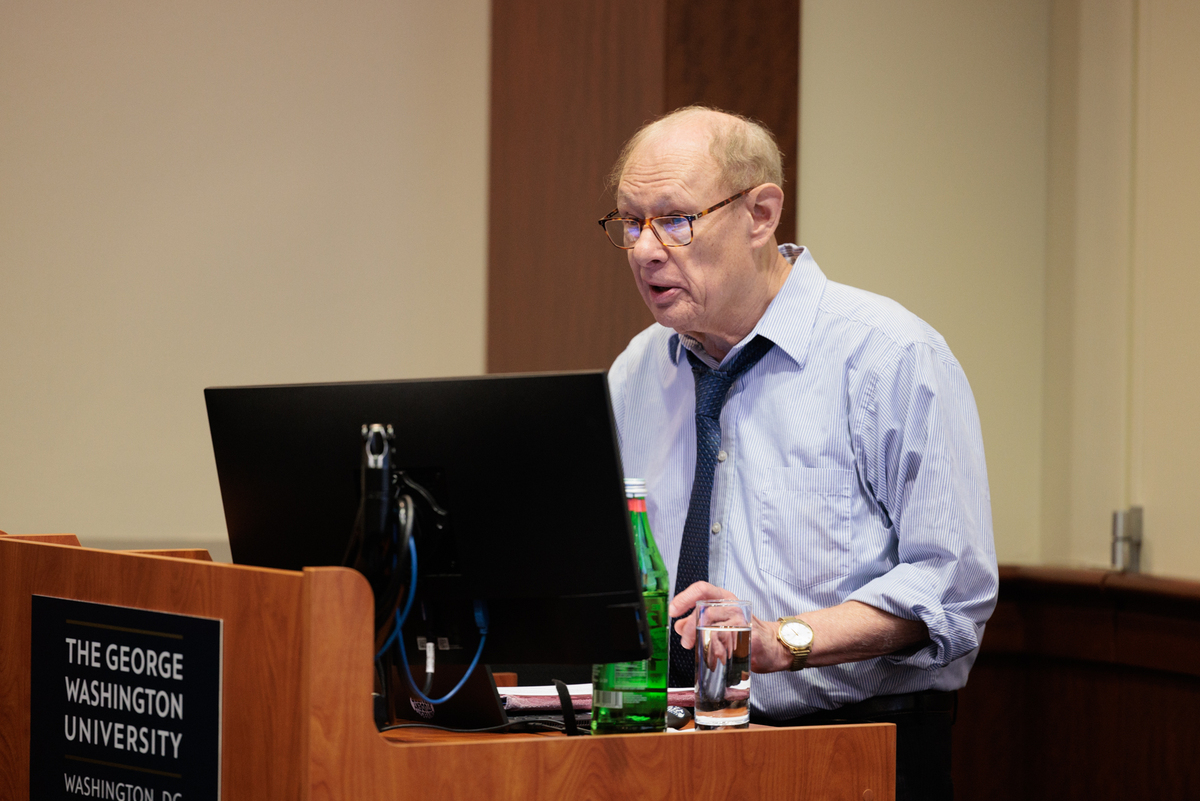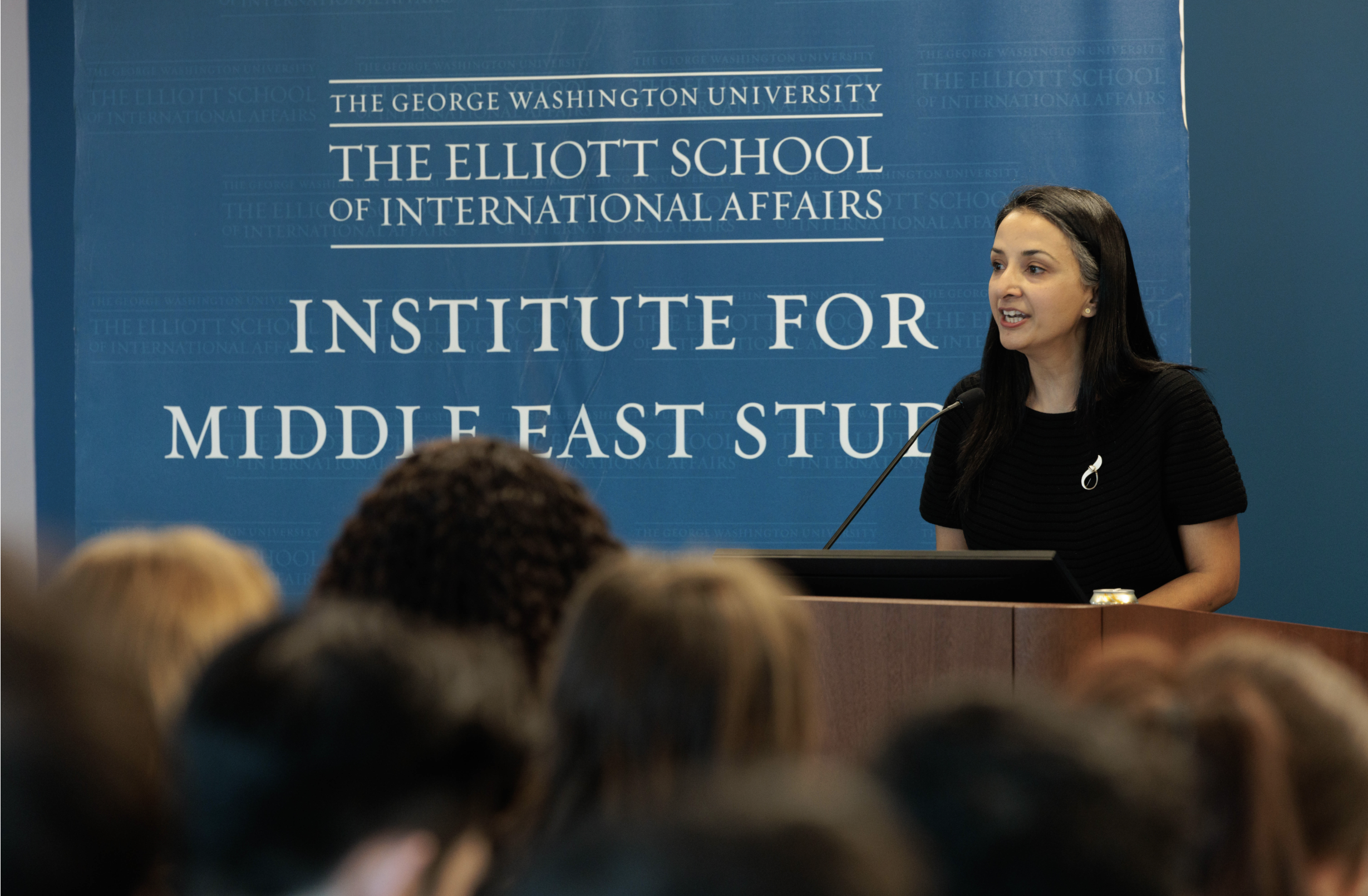George Washington University hosted Mark Tessler, the Samuel J. Eldersveld Collegiate Professor at the University of Michigan, to give a historical overview of the Israeli-Palestinian conflict and how that connects to the present situation in the region.
Tessler has written extensively on the Israeli-Palestinian conflict and conducted field research in Israel, the West Bank and Gaza.
The lecture, “Overview of the Israeli-Palestinian Conflict: Critical Junctures, Past and Present,” was organized by the Lecture Series Faculty Working Group as part of GW’s Strengthening Our Community Initiative.
Teresa Murphy, the deputy provost for academic affairs, introduced the event.
“I want to welcome all of you to this inaugural lecture as part of GW’s Strengthening Our Community Initiative,” Murphy said. “As part of that initiative, President Ellen Granberg and Provost Christopher Bracey asked the faculty to join in working groups and work creatively to enrich our environment as we grapple with world problems.”
Murphy thanked Granberg for her enthusiasm in supporting the initiative.
“We are all here because vigorous and broad dialog about critical issues is a hallmark of the GW experience and essential to our university’s ability to foster social and intellectual growth,” Murphy said.
Tessler began his lecture by highlighting the need to understand the historical context of the conflict. He explored the early histories of both Jews and Arabs, noting significant moments in both of their histories, including the era of the Hebrew Bible and the rise of Arab empires.
“I point out what is an interesting and potentially surprising symmetry between the two,” Tessler said.
He traced similar challenges both groups faced, including periods of displacement and revival, and challenges in trying to navigate ties with European powers.
In explaining the history of the conflict, Tessler said that he wanted to move away from the oversimplified notion that the conflict stems from ancient religious animosities. Instead, he spoke about watershed events that have impacted the trajectory and evolution of the conflict.
Tessler outlined part of what gave rise to modern Zionism in the 19th century. While there were reforms in Europe that offered Jews opportunities to integrate, such as attending universities and owning property, there were also instances like the pogroms, which were violent attacks on Jews in Eastern Europe. This fueled the rise of Zionism where Jews supported taking initiative in order to reclaim their land.
The Balfour Declaration came about in 1917. It promised a Jewish national home in Palestine and offered protections for the civil and human rights of non-Jewish citizens.
“Interestingly, it's not the political right, it's only the civil rights and the human rights of the non-Jewish citizens and political rights are only for Jews,” Tessler said. “And so, the Jews signed on and the Palestinians weren’t accepting so this didn’t go anywhere. But I tell the story just to lay a foundation for thinking about these people and not jumping in and saying, ‘All I know about them is they fought with one another forever, they hate each other, and it’s based on ancient religious antagonism.’ None of which is correct. So, we try to set a scene that moves us away from that.”
In the early 20th century, he said, particularly after World War I when the Ottoman Empire collapsed and Arab territories, including Palestine, were no longer under Ottoman control, some early Jewish and Arab leaders explored cooperation by drawing on shared histories of oppression. But ultimately, those attempts fell apart.
Violence erupted between Arabs and Jews in the region. More Jewish people continued to settle in the area, purchasing land and homes. Between 1936 and 1950, there were many Jewish institutions in the region, including Hebrew universities.
The British were a dominant power in the region and in 1937, the Peel Commission proposed a two-state solution to the conflict for the first time. The Jews said they couldn’t accept the map but were willing to negotiate on the principle of partition. The Palestinians rejected the idea saying they didn’t want to give away half their territory.
In 1948, Israel declared its independence, and fighting broke out with neighboring Arab nations. Eventually, Israel took control of the territory that had been allocated to the Palestinians and about 750,000 Palestinians became refugees.
The Camp David Accords, peace talks between Israel and Egypt, facilitated by former President Jimmy Carter, began in 1978. Egyptian President Anwar Sadat told Israel he could offer a "complete peace" in the region rather than just a separate peace with Egypt. Sadat urged other Arab nations to engage in negotiations with Israel. Eventually the agreement “A Framework for the Conclusion of a Peace Treaty between Egypt and Israel” was reached.
The issue of Palestinian autonomy brought challenges to the negotiations. A second framework that included a plan for Palestinian self-rule in the West Bank and Gaza Strip was proposed but ultimately not implemented. Israel rejected the plan due to a reluctance to withdraw for security reasons while Palestinians opposed ceding territory.
Looking at modern-day events, Tessler said, this historical context continues to shape the conflict today.
He said that future negotiations may focus on secondary issues, leading to missed opportunities to address the deeper, more critical challenges that hinder peace including the issue of Palestinian autonomy. Tessler noted that the two-state solution will continue to be proposed as the only viable option, but expressed concern that ongoing talks might overlook the fundamental changes happening on the ground.
"People around the table may be bargaining in good faith, but they're spending a lot of time talking about things that are important but ultimately secondary, while things in the primary are changing on the ground,” Tessler said.



